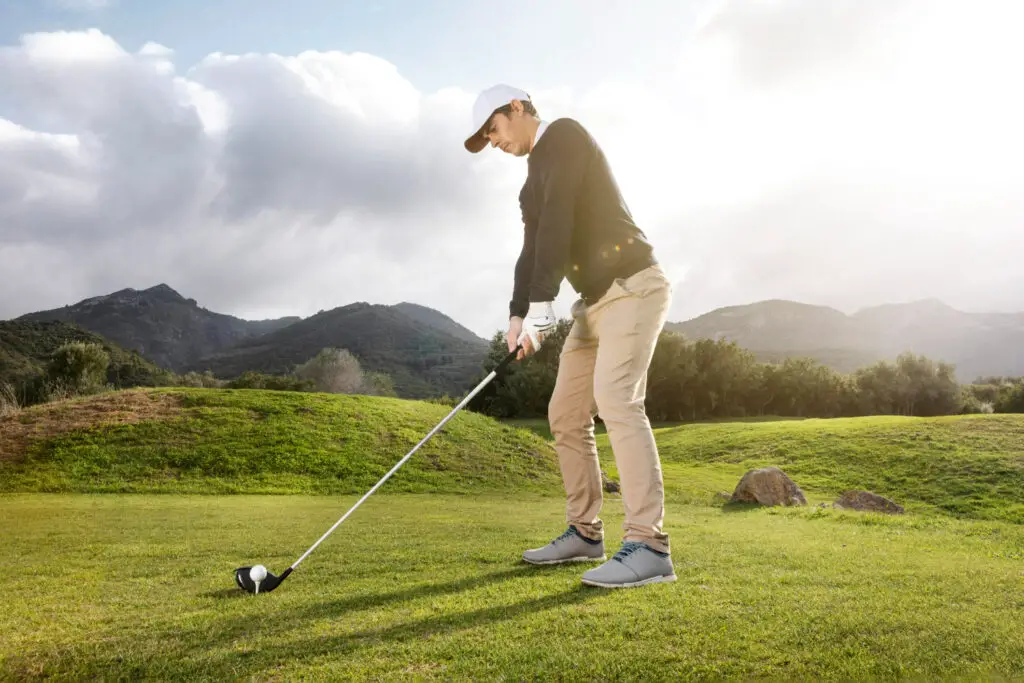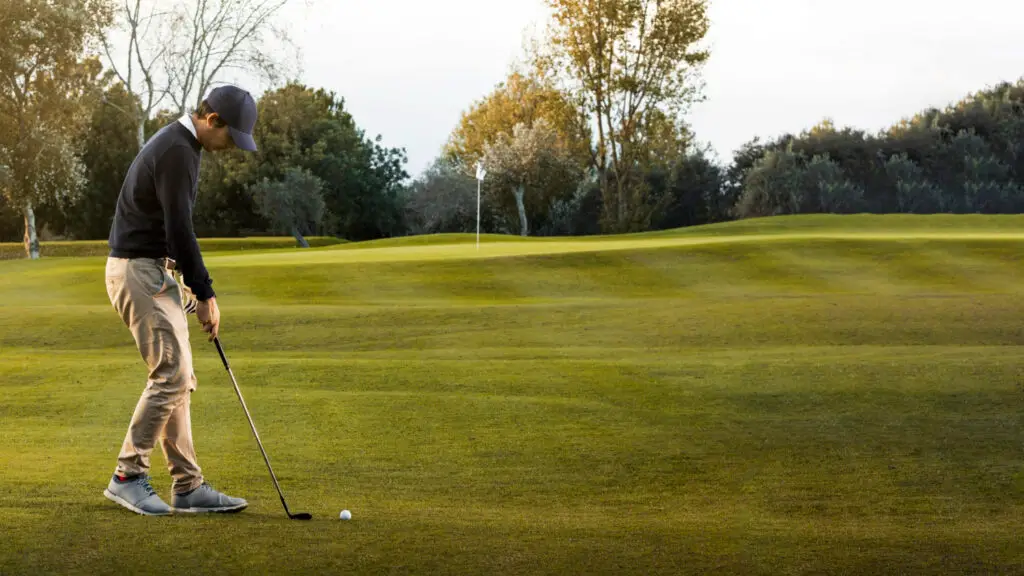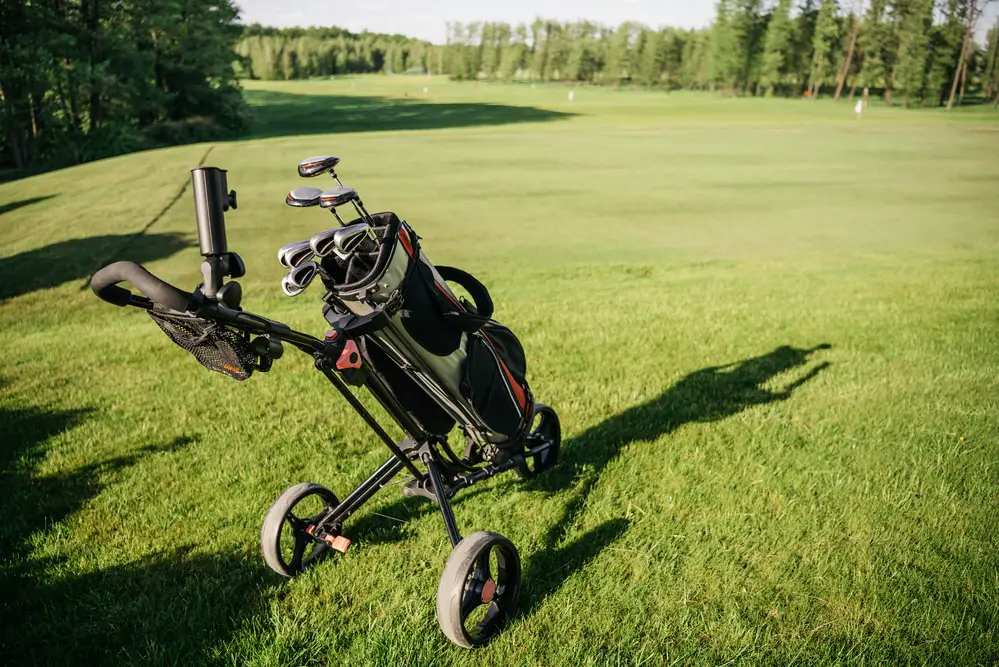Last Updated on October 25, 2023
Golfers must pay close attention to the length of their putter. This is because having the correct size and shape for each putt drastically influences how well it will be played. The ideal length of a golf putter depends on the individual’s height, arm length, and any physical restrictions or disabilities. Therefore, measuring properly before purchase is essential in ensuring optimal performance when playing golf. Today’s article aims to teach you how to measure a golf putter’s length so that you can find the best fit.
Benefits of a Properly Fitted Putter
Having a properly fitted putter is essential to improving one’s putting accuracy and confidence. This can be achieved by measuring the length of the putter against their posture when standing over the ball. The putter should fit comfortably in both hands, with elbows slightly bent and shoulders relaxed. When gripping the club, arms should hang naturally from their sides rather than being forced into an awkward position. If these conditions are met, then it becomes easier for golfers to make consistent contact with the ball as well as use optimal technique while putting.
In addition to comfort and better technique, having a properly fitted putter can also help improve a golfer’s performance on the green. With correct grip size and length, players can maintain proper wrist action throughout their stroke, which leads to more consistency overall. Properly adjusted loft and lie angles also contribute to improved accuracy since they affect how far the ball will travel after impact. Therefore, taking the time to measure a putter correctly can make all difference between missed opportunities and successful shots on the course.
Equipment Needed to Measure Putter
Measuring a golf putter requires specific equipment. The necessary items for accurately measuring the length of a putter are:
- A ruler with at least two inches of accuracy
- Putter fitting tools such as an adjustable grip or head weight kit
- A putter measuring tape
- An assistant to ensure accuracy
When using these instruments to measure the length of a golf putter, it is important to use the correct technique and maintain accurate measurements throughout the process. To do this, start by laying the ruler across the top side of the centre shaft between the clubhead and grip. Make sure that there is no pressure on either end while placing the ruler in place. This will provide an accurate measurement when taking note of where each end falls along the scale. It is also recommended that you have someone else help take note of exact measurements if possible so that errors can be avoided.

Furthermore, make sure to utilise any extra features, such as adjustable grips or head weights kits, before finalising any decisions regarding your purchase. Allowing yourself time to experiment properly with different lengths and head weights will give you greater confidence in your chosen putter once you’ve made a decision about which one best suits your needs. With all these factors taken into consideration, you should now have enough knowledge to confidently select and size up your new putter accurately.
How to Determine Your Grip Size
Grip size selection is an important factor in determining the correct putter length. The golfer should select a grip size that fits their hand comfortably, as this will lead to better control over the club and improved accuracy on the green. Factors such as hand circumference, finger width, glove size and strength of grip should all be considered when selecting grip size.
In order to determine which grip size is most suitable for them, golfers can measure the distance between their index finger knuckle and middle finger knuckle using a ruler or tape measure. This measurement can then be used to compare with guidelines from golf equipment manufacturers who provide sizing charts for different types of grips available on the market. Once a fitting grip size has been found, it can then be installed onto the shaft of the putter prior to use.
How to Choose the Right Length Putter

Golfers should also take into account their arm-to-club ratio when looking at putter fitting tips. Generally speaking, taller players need longer clubs than shorter players because they have a greater distance between their arms and hands while standing over the ball. Shorter players may require shorter clubs since they tend to stand more upright with less space between their arms and hands while making a stroke. Additionally, some golfers prefer using belly putters or long putters based on preference as well as physical needs; these types of clubs are generally longer than standard models.
When shopping for a new putter, it’s essential to find one that matches your measurements so that you can enjoy consistent results on the green. Golfers should try out several different models before purchasing to ensure they make the right selection for their game. A professional club fitter can also provide assistance with this process by helping them decide which type of club is optimal for their height and posture during play.
Common Putter Lengths and Their Uses
Golf putters come in a variety of lengths, with the most common being standard length, belly length and counterbalanced. Standard-length putters measure 35 inches (89cm) from tip to grip end and are suitable for golfers who stand around 6 feet tall or slightly less. Belly-length putter measures between 33–35 inches long (83 and 89 cm), depending on the manufacturer, and is designed for those who stand 5’7″ or lower. Counterbalanced putters feature extra weight either near the head or at the butt end of the shaft that helps balance out the swing when using heavier grips. They also have an extended length ranging anywhere from 38–45 inches (96 – 114 cm). This allows players to generate more power behind each stroke while maintaining control over their putting action.
All three types of the putter can be adjusted by cutting down part of the shaft, but it’s important to make sure there’s no change in flex characteristics so as not to alter performance during play. Ultimately, selecting the correct length of a putter depends on personal preference and what you feel comfortable with during your game.

How to Take Accurate Measurements
Taking accurate measurements of a golf putter is an important step in ensuring the correct length. To begin, it’s best to use a ruler or measuring tape specifically designed for golf clubs. The below table provides some additional tips on taking accurate measurements.
| Tip | Description |
|---|---|
| 1. Choose the Right Ruler | A standard 12-inch ruler won’t be able to accurately measure club lengths due to their unique shapes and sizes. Instead, purchase specialised rulers made specifically for golf clubs that can easily fit inside even small spaces between grooves and components. |
| 2. Measure from the Butt End | Measure from the butt end of your grip instead of the head or shaft because this will help ensure a more consistent measurement each time. Make sure you’re using the same point on your grip every time as well by marking with a permanent marker if necessary. |
| 3. Putter Measuring Protocol | When measuring your putter, make sure you are following proper protocol: start at the butt end (grip) and work down until you get to the bottom edge of where the sole meets up with the hosel/shaft area; then record your numbers accordingly – usually in inches but sometimes centimetres depending on what type of meter you use; repeat this process 3 times before considering it an official measurement for accuracy’s sake! |
Frequently Asked Questions
Is It Possible to Adjust the Length of a Putter?
It is possible to adjust the length of a putter, although this should be done with care. Putters come in different lengths, and each individual golfer will have their own preference when it comes to what they find comfortable. Adjusting the putter length can involve altering the shaft or even shortening the grip. This kind of modification should only be performed by a professional golf club technician, as there are specific measurements that must be taken into consideration for optimal results.
The length adjustment process depends on the type of putter being used; blades tend to require less change than mallets which usually need more alteration due to their larger head size. The main considerations for the purpose of adjusting putter length include lie angle, loft angle, swing weight and overall balance. As part of any putter length adjustment, an experienced technician takes all these factors into account before making changes so that players enjoy improved accuracy and control over their shots.
What Are the Benefits of Using a Longer or Shorter Putter?
When discussing the benefits of using a longer or shorter putter, it is important to consider how this can affect accuracy in putting. Generally speaking, a longer putter provides more stability and control due to its larger size; however, it requires more energy and effort during the putting stroke. A shorter putter, on the other hand, gives less stability but allows for easier manipulation of ball speed and direction since it has lesser inertia than a longer one. As such, golfers must decide which length offers them better accuracy when putting.
In terms of greater accuracy with either type of club, there are certain factors that come into play. Longer putters can offer improved consistency thanks to their increased mass weight compared to shorter ones, as well as providing stronger feedback from contact with the ground due to its lower centre of gravity. On the flip side, shorter putters have been found to be useful when playing in tight spaces because they produce less distance-robbing sidespin off the face, thus allowing players more control over short shots around greens. Ultimately, each individual golfer needs to assess what works best for them based on their own physical attributes and preferences.
Conclusion
In conclusion, measuring golf putter length is an important factor in achieving optimal accuracy and success on the green. Knowing how to measure a golf putter correctly can be beneficial for any golfer looking to improve their performance on the course. The two main types of putters are blade and mallet, with each type having different characteristics that affect its overall design and fit. It is possible to adjust the length of a putter as well as purchase certain brands that are better suited for particular lengths.
Additionally, understanding how putting lengths influence accuracy can help players identify what works best for them and make adjustments accordingly. Ultimately, being aware of different aspects related to golf putter length can provide insight into enhancing one’s game.



